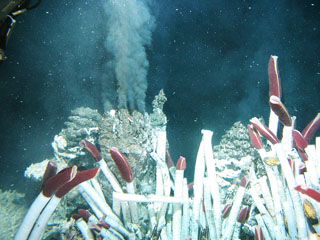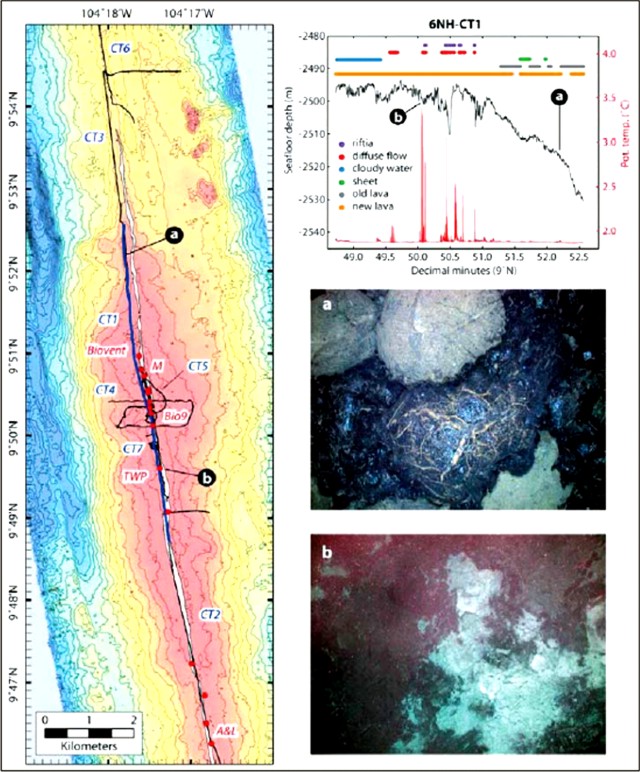Report on Northern EPR at 9.8°N (Undersea Features) — March 2007
Bulletin of the Global Volcanism Network, vol. 32, no. 3 (March 2007)
Managing Editor: Richard Wunderman.
Northern EPR at 9.8°N (Undersea Features) Fresh lava flows documented along ridge for over 15 km
Please cite this report as:
Global Volcanism Program, 2007. Report on Northern EPR at 9.8°N (Undersea Features) (Wunderman, R., ed.). Bulletin of the Global Volcanism Network, 32:3. Smithsonian Institution. https://doi.org/10.5479/si.GVP.BGVN200703-334050
Northern EPR at 9.8°N
Undersea Features
9.83°N, 104.3°W; summit elev. -2500 m
All times are local (unless otherwise noted)
Along the fast spreading East Pacific Rise (EPR) crest near 9°50'N, Cowen and others (2007) reported on additional evidence regarding recent volcanic eruptions spanning about 4-5 months of activity discovered in April and May 2006. In April 2006, during routine recovery and redeployment of ocean-bottom seismometers (OBS) at the EPR R2K Integrated Study Site (ISS) near 9°50'N, eight of 12 OBS could not be recovered (BGVN 31:11). Anomalous turbidity and temperature in the water column along the ridge axis confirmed scientists' suspicions that the OBS were trapped by a new lava flow. A resurgence in magmatism had been postulated recently, based on temporal changes observed over the past few years in hydrothermal vent fluid chemistry and temperatures (Von Damm, 2004) and increasing microseismicity (Tolstoy and others, 2006).
According to Cowen and others (2007), within a week of the initial bottom-water surveys in late April, scientists mounted a rapid response expedition on board the research vessel RV New Horizon. The expedition surveys included conductivity-temperature-depth (CTD) observations, optical tow-yos (tows during which a package is alternately lowered and raised), hydrocasts, and towed digital-imaging along the EPR axis between ~ 9°46'N and 9°57'N.
These surveys confirmed the occurrence of recent seafloor eruptions along more than 15 km of the ridge axis and up to ~ 1 km off axis. They documented widespread vigorous hydrothermal venting and a notable absence of vent megafauna (figure 6). Many of the hydrothermal vents studied over the past 15 years were disrupted. A prior eruption occurred in 1991-1992 (e.g., Haymon and others, 1993) along portions of the same segment of the EPR. This is the first repeat eruption documented at the same location along the mid-ocean ridge (MOR) crest.
Toomey and others (2007) discussed how mantle upwelling is essential to the generation of new oceanic crust at mid-ocean ridges, and concluded that such upwelling is asymmetric beneath active ridges. In their article, the authors used seismic imaging to show that the isotropic and anisotropic structure of the mantle is rotated beneath the East Pacific Rise. The isotropic structure defines the pattern of magma delivery from the mantle to the crust. They found that the segmentation of the rise crest between transform faults correlates well with the distribution of mantle melt. The azimuth of seismic anisotropy constrains the direction of mantle flow, which is rotated nearly 10° anticlockwise from the plate-spreading direction. The mismatch between the locus of mantle melt delivery and the morphologic ridge axis results in systematic differences between areas of on-axis and off-axis melt supply. The authors conclude that the skew of asthenospheric upwelling and transport governs segmentation of the East Pacific Rise and variations in the intensity of ridge crest processes.
References. Cowen, J.P., Fornari, D.J., Shank, T.M., Love, B., Glazer, B., Treusch, A.H., Holmes, R.C., Soule, S.A., Baker, E.T., Tolstoy, M., and Pomraning, K.R., 2007 (13 February), Volcanic Eruptions at East Pacific Rise Near 9°50'N: Eos, Transactions, American Geophysical Union, v. 88, no. 7, p. 81, 83.
Haymon, R.M., Fornari, D.J., Edwards, M.H., Carbotte, S., Wright, D., and Macdonald, K.C., 1991, Hydrothermal vent distribution along the East Pacific Rise crest (9 deg 9'-54' N) and its relationship to magmatic and tectonic processes on fast-spreading mid-ocean ridges: Earth and Planetary Science Letters, v. 104, p. 513-534.
Haymon, R.M., Fornari, D.J., Von Damm, K.L., Lilley, M.D., Perfit, M.R., Edmond, J.M., Shanks, W.C., III, Lutz, R.A., Grebmeir, J.M., Carbotte, S., Wright, D., McLaughlin, E., Smith, M. Beedle, N., and Olson, E., 1993, Volcanic eruption of the mid-ocean ridge along the East Pacific Rise crest at 9 deg 45-52 min N: direct submersible observations of seafloor phenomena associated with an eruption event in April 1991: Earth and Planetary Science Letters, v. 119, p. 85-101
Toomey, D.R., Jousselin, D., Dunn, R.A., Wilcock, W.S., and Detrick, R.S., 2007, Skew of mantle upwelling beneath the East Pacific Rise governs segmentation: Nature, v. 446, p. 409-414 (doi:10.1038/nature05679).
Tolstoy, M., J.P. Cowen, E.T. Baker, D.J. Fornari, K.H. Rubin, T.M. Shank, F. Waldhauser, D.R. Bohnenstiehl, D.W. Forsyth, R.C. Holmes, B. Love, M.R. Perfit, R.T. Weekly, S.A. Soule, and B. Glazer, 2006, A sea-floor spreading event captured by seismometers: Science, v. 314, no. 5807, p. 1920-1922.
Von Damm, K. L., 2004, Evolution of the hydrothermal system at East Pacific Rise 9°50'N: Geochemical evidence for changes in the upper oceanic crust, in C. German and others (ed), Mid-Ocean Ridges: Hydrothermal Interactions Between the Lithosphere and Ocean: Geophys. Monogr. Ser., v. 148, p. 285-304.
Geological Summary. A series of dives with the submersible Alvin in 1991 on the East Pacific Rise at about 9°50'N detected evidence for a very recent, possibly ongoing, eruption. Hot-vent animal communities documented during November-December 1989 had been buried by fresh basaltic lava flows, and the scorched soft tissues of partially buried biota had not yet attracted bottom scavengers. Fresh black smoker chimneys and new lava flows were present. This site is south of the Clipperton Fracture Zone at a depth of about 2,500 m, and about 1,000 km SW of Acapulco, México; the south end of the Lamont Seamount chain is about 10 km NW. This is also the location where lava flows previously estimated as being less than roughly 50 years old had been found. Later dating using very short half-life radionuclides from dredged samples confirmed the young age of the eruption and indicated that another eruptive event had taken place in late 1991 and early 1992. An eruption in 2005-2006 produced lava flows that entrapped previously emplaced seismometers.
Information Contacts: RV New Horizon and Scripps Institution of Oceanography, University of California - San Diego, 8602 La Jolla Shores Drive, La Jolla, CA 92037, USA (URL: http://sio.ucsd.edu/); Woods Hole Oceanographic Institution, Woods Hole, MA 02543, USA (URL: http://www.whoi.edu/).


